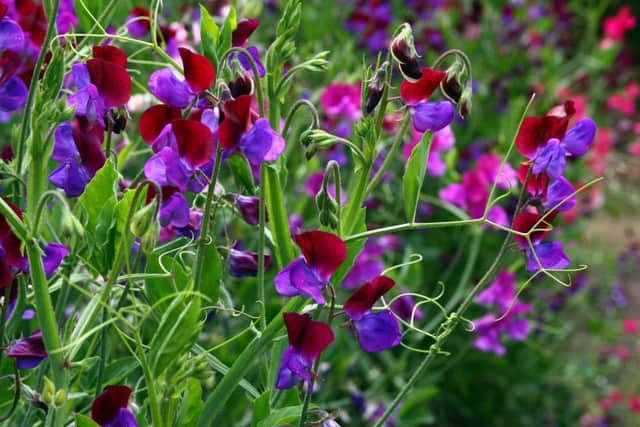Brian Kidd says you can't beat sweet peas for a heaven-scent summer


If you don’t have a garden there are varieties bred for window boxes, tubs and hanging baskets. Look for Bijou mixed or Explorer.
If, however, you have a good sunny spot with plenty of height available and you want the quickest possible screen, grow tall sweet peas especially bred for the exhibitor. You should get four or five blooms on 10in-long stems. You will be able to pick bunches from June until the end of August.
Advertisement
Hide AdAdvertisement
Hide AdWhen looking at the seed packets make sure the varieties you choose are fragrant. Not all exhibition types are perfumed.
Serious growers tell you to sow the seeds in October in a cold frame, but one of our best commercial exhibitors always sows his in the first week of April in a temperature of 18C (65F). If you can’t get a constant 18C, the airing cupboard is ideal. Mid-April is quite suitable for seed-sowing.
Sweet peas must be sown in deep pots as they make a long initial root. Here’s a good tip. Save the cardboard tubes from toilet and kitchen rolls and sow two seeds in each tube using any seed compost to fill them. If you are wondering about the length of kitchen roll tubes, yes, cut them in half. You could also use rolled-up newspaper. Keep them in shape with rubber bands.
Sweet pea seeds have a hard coat. Shake each variety in dry sand in a glass jar with a screw top for five minutes. Soak them overnight in rain water to make them swell. If sown in the warm, they will usually germinate in about 10-20 days.
Advertisement
Hide AdAdvertisement
Hide AdWhen this happens put them in full light and once there are eight pairs of leaves, nip out the tops of all plants to encourage good strong stems to emerge from the base.
Now make sure the place where they will grow is well-cultivated. Dig a trench at least 12in deep and 3ft wide and work in as much organic matter as you can. This can be compost or well-rotted manure, mushroom manure, rotted grass mowings or rotted bedding from rabbits and guinea pigs. By the time the seedlings are ready to be planted, the ground will have settled and the soil’s bacteria started to have turned the organic matter into humus.
Staking is vital for good, long-stemmed blooms. Eight-foot canes are best. Insert them into the ground so 10in of each cane is buried. They should be 8in apart with 12-15in between the rows.
They are big feeders so 10 days before planting them out in mid-May, scatter fish blood and bone fertiliser or Vitax Q4 fertiliser at 4oz a square yard over the soil’s surface and rake it in to a depth of about 3in. After 10 days, plant one plant to each cane. As they grow, tie in the leaf stalks to the cane and pinch out all tendrils and side shoots. Do this daily and you will see the first bloom buds forming once the stems are 4ft high.
Advertisement
Hide AdAdvertisement
Hide AdIf you can’t be bothered with all this, get hold of a big bundle of pea sticks and fix them up like a wigwam. Plant the plants and leave them alone. You will still have a good show but with shorter stems and it won’t affect the perfume!
TIP OF THE WEEK
A handy sprayer containing ready-made Roundup weedkiller is useful for spraying weeds in cracks in paths at this time of year. Roundup kills all plants so take care it does not drift on to cultivated plants.